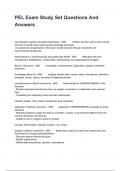PEL Exam Study Set Questions And
Answers
Jean Piaget's cognitive developmental theory - ANS -Children are born with a basic mental
structure on which future learning and knowledge are based.
-A progressive reorganization of the basic mental structure through maturation and
environmental experiences.
What behavior is most frequently associated with ADHD - ANS difficulties with time
management, forgetfulness, losing things, daydreaming, and organizational struggles
Bloom's Taxonomy - ANS knowledge, comprehension, application, analysis, synthesis,
evaluation
Knowledge (Bloom's) - ANS recalling specific facts, names, dates, descriptions, definitions,
principles, trends, criteria, and ways of organizing events
comprehension in Bloom's taxonomy - ANS Demonstrate an UNDERSTANDING of the
facts/text
- Student responses should show they can explain, summarize, or elaborate on the learned
facts
- Translating and rephrasing what has been read/spoken
(classify, explain, infer, predict, paraphrase, give examples)
application in Bloom's taxonomy - ANS Applying or TRANSFERRING knowledge to actual
situations
- Requires students to apply the facts to a problem, context, or environment different from the
one the information was learned
- Unable to rely on original context or content
(change, demonstrate, illustrate, practice, use, show)
analysis in Bloom's taxonomy - ANS Break down objects or ideas into simpler parts and
find evidence to support generalizations
- Discover reasons behind info given
- Identify logical errors
- Differentiate among facts, opinions, assumptions
, - Derive conclusions
- Make inferences/generalizations
(support, distinguish, break down, differentiate, relate, compare, contrast, examine)
synthesis in Bloom's taxonomy - ANS using old concepts to create new ideas, design and
invention, composing, imagining and inferring, modifying, predicting and combining
evaluation in Bloom's taxonomy - ANS assessing theories, comparison of ideas, evaluating
outcomes, solving, judging, recommending and rating.
kinesthetic learning - ANS a learning style in which the individual learns through completing
physical activity or movement
Most common mental health issue among adolescents? - ANS depression
What can you do to support students with depression? - ANS give specific supports to
function effectively in the school enviornmet. develop classroom support plans.
Stages of Erikson's Theory of Psychosocial Development - ANS -Describes the impact of
social experience across a lifespan.
trust v. mistrust
autonomy v. shame & doubt
initiative v. guilt
industry v. inferiority
identity v. role confusion
intimacy v. isolation
generativity v. stagnation
integrity v. despair
Trust v. Mistrust Stage - ANS 0-18 mo.
according to Erikson, the period during which infants develop a sense of trust or mistrust, largely
depending on how well their needs are met by their caregivers
Autonomy v. Shame and Doubt - ANS toddler (18 mo- 2/3yrs) They assert their sense
independence and do things on their own. If restrained or punished too harshly, they are likely to
develop a sense of shame & doubt
Initiative vs. Guilt - ANS 3-5 yrs. Erikson's third stage in which the child finds independence
in planning, playing and other activities
Industry vs. Inferiority - ANS 6-11yrs. social world expands. begin socially interacting more.
form a strong self-concept




